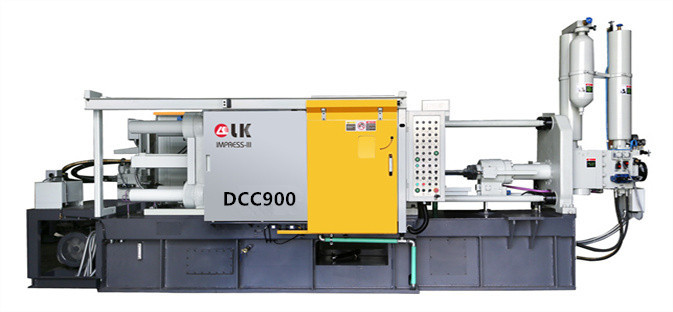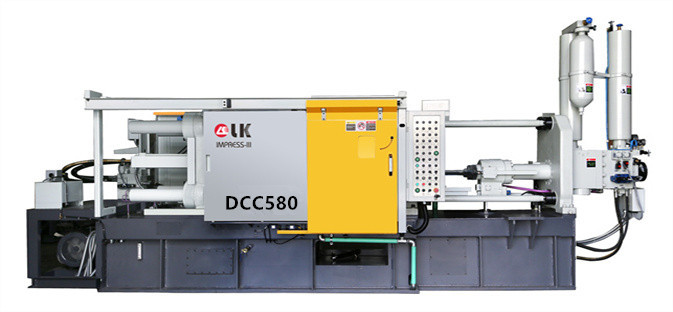What are the Two Types of Die Casting Machines?
LK Die Casting Machine / 2024-07-16 14:37:49
Die-casting machines are indispensable equipment in modern manufacturing, which are used to inject molten metal into molds to form high-precision and high--
strength metal parts.
According to the different structures and working principles, die-casting machines are mainly divided into two types: hot chamber die-casting machines and cold
chamber die-casting machines.

This article will introduce the characteristics, application scope, and advantages and disadvantages of these two die-casting machines in detail.
1. Hot chamber die-casting machine
The hot chamber die casting machine, also known as the gooseneck die casting machine, is a device suitable for low melting point metals such as zinc, magnesium and
tin alloys.
The characteristic of the hot chamber die-casting machine is that its die-casting chamber is directly immersed in the molten metal, and the die-casting process is
fast and efficient.
1.1 Structure and working principle
The main components of the hot chamber die-casting machine include the die casting chamber, gooseneck tube, nozzle, mold and clamping mechanism. Its working
the principle is as follows:
Die-casting chamber heating: The die casting chamber is directly heated to the required temperature to keep the metal in a molten state.
Injection of molten metal: The molten metal is injected into the die casting chamber through the gooseneck tube, and then the metal is injected into the mold
through the nozzle.
Cooling and solidification: The metal cools and solidifies rapidly in the mold to form the desired casting shape.
Opening the mold and taking out the casting: The mold is opened and the solidified casting is taken out.
1.2 Advantages
High efficiency: Since the die-casting chamber is directly heated, the metal melting and injection process is rapid, which is suitable for mass production.
Low energy consumption: The die-casting chamber is in direct contact with the molten metal, which reduces heat loss and has low energy consumption.
Simple operation: The operation of the hot chamber die casting machine is relatively simple, with a high degree of automation and convenient maintenance.
1.3 Disadvantages
Temperature limitation: Since the die casting chamber and gooseneck are immersed in the molten metal, high melting point metals (such as aluminum and copper)
cannot be processed.
Limited material selection: It is mainly suitable for low melting point metals and is not suitable for applications with high strength requirements.
1.4 Scope of application
Hot chamber die casting machines are mainly used to manufacture small and complex parts, such as electronic components, toys, locks, automotive parts, etc.
These parts do not require high melting points of materials but have high production efficiency and precision requirements.
2. Cold chamber die casting machine
A cold chamber die casting machine is a kind of equipment suitable for high melting point metals, such as aluminum, copper, and magnesium alloys. The
characteristic of a cold chamber die casting machine is that its die casting chamber is separated from the furnace, which is suitable for high temperature and
high-pressure working environment.
2.1 Structure and working principle
The main components of a cold chamber die casting machine include a die-casting chamber, injection punch, mold and mold clamping mechanism. Its working principle
is as follows:
Furnace melting metal: metal is heated to a molten state in an independent furnace.
Injection metal: molten metal is scooped out of the furnace and poured into the die casting chamber of the cold chamber die casting machine.
Shot metal: injection punch presses molten metal from the die casting chamber into the mold.
Cooling and solidification: metal cools and solidifies rapidly in the mold to form the desired casting shape.
Open mold and take out: the mold is opened and the solidified casting is taken out.
2.2 Advantages
Applicable to high melting point metals: it can handle high melting point metals such as aluminum and copper, expanding the range of material selection.
High-strength castings: Suitable for manufacturing high-strength and high-durability metal parts.
Flexibility: Suitable for castings of various sizes and shapes, with wide adaptability.
2.3 Disadvantages
Low efficiency: Since the metal needs to be scooped out of the furnace and poured into the die-casting chamber, the production process is slow.
High energy consumption: A separate furnace is required to heat the metal, which consumes a lot of energy.
Complex operation: The operation process is relatively complicated, the requirements for technicians are high, and the maintenance is also relatively complicated.

2.4 Scope of application
Cold chamber die-casting machines are mainly used to manufacture medium and large castings, such as automobile engine blocks, gearbox housings, and electronic
communication equipment housings.
These castings require high strength and durability and are large in size.
Conclusion
Hot chamber die casting machines and cold chamber die casting machines have their own advantages and disadvantages, and are suitable for different types of metals
and castings.
Hot chamber die casting machines are suitable for small and complex parts of low melting point metals, with the advantages of high efficiency and low energy
consumption, but are limited by temperature and material selection.
Cold chamber die casting machines are suitable for large, high-strength castings of high-melting-point metals. Although they are less efficient and have higher
energy consumption, they are more adaptable.
When choosing the type of die-casting machine, companies should make comprehensive considerations based on specific production needs, material properties, and
casting requirements to select the most suitable die-casting equipment.
Understanding the characteristics and application scope of these two types of die-casting machines will help companies improve production efficiency, reduce costs,
and improve product quality.
For more info, you can refer to: https://www.youtube.com/shorts/JLX410QV_kw
Contact LK Egypt to learn more info about the die-casting machine
LKAGENT OFFICE DCM
Address: Industry Zone, South of Port Said Kebly, Egypt
https://www.zazdiecasting.com/
Phone/WhatsApp/Wechat: +86 13598704163
Mobile: +20 101 304 3317 +20 150 181 8310
Email: jack@zazmae.com ahmedmahmoud@zazmae.com
#die cast tooling
#trivalent chromate
#rapid prototype casting
#a360 aluminum
#aluminum caster
#aluminum prototype
#ideal 55 slider parts
#density of aluminum kg/mm3
#magnesium sheet metal
#parts of a metal gate
#subcontracting of screw machining for the luxury sector
#wall aluminum
#die casting tooling
#tooling for die casting
#density of aluminium in kg mm3
#clear chromate
#es casting metals
#gating material
#prototype aluminum
#sigma castings
#subcontracting of screw-machining for household appliances
#we squeeze to please machine
#aluminium gravity die casting
#aluminum part
#aluminum rapid prototyping
#nickel casting
#plunger tip for die casting machine
#rapid prototyping aluminium
OTHER CONTENT
-

2024-09-19 14:16:15 LK Cold Chamber Die Casting Machine DCC900 Locking Force: 9000KN Die Height: 400-1000mm Space Between Tie Bars: 930x930mm Shot Weight: 13.5Kg Casting Area Max:2250c㎡
More -

2024-09-19 14:11:06 LK Cold Chamber Die Casting Machine DCC280 Locking Force: 2800KN Die Height: 250-650mm Space Between Tie Bars: 560x560mm Shot Weight: 2.9Kg Casting Area Max:700c㎡
More -

2024-09-19 10:23:07 LK Cold Chamber Die Casting Machine DCC580 Locking Force: 5000KN Die Heigh: 350-850mm Space Between Tie Bars: 760x760mm Shot Weight: 6.9Kg Casting Area Max:1250c㎡
More -

2024-09-19 10:11:20 LK Cold Chamber Die Casting Machine DCC400 Locking Force: 4000KN Die Height: 300-700mm Space Between Tie Bars: 669x669mm Shot Weight: 4.7Kg Casting Area Max:1000c㎡
More

